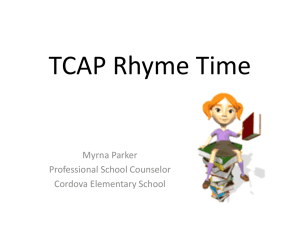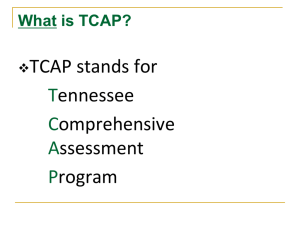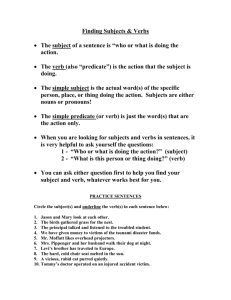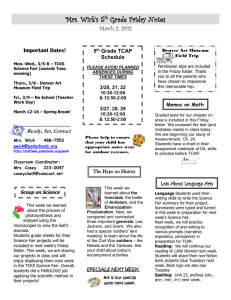File
advertisement
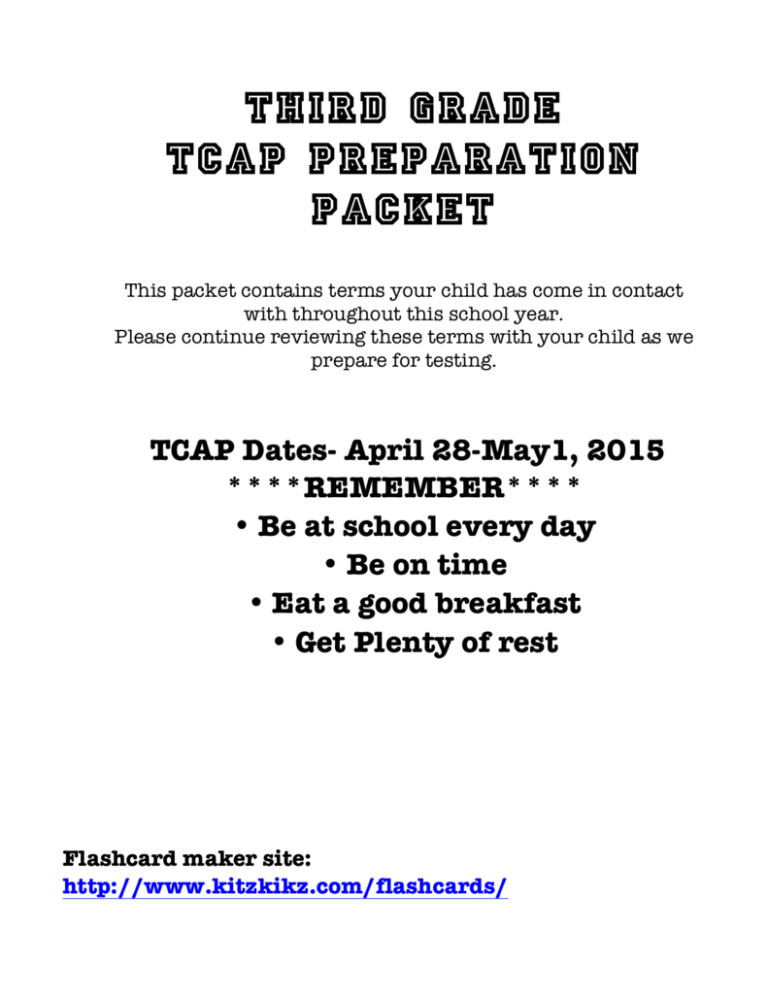
Third Grade TCAP Preparation Packet This packet contains terms your child has come in contact with throughout this school year. Please continue reviewing these terms with your child as we prepare for testing. TCAP Dates- April 28-May1, 2015 ****REMEMBER**** • Be at school every day • Be on time • Eat a good breakfast • Get Plenty of rest Flashcard maker site: http://www.kitzkikz.com/flashcards/ Math Terms to know: Sum-­‐ to add numbers Difference-­‐ to subtract numbers Product-­‐ to multiply numbers area-­‐ length x width (the number of square units covering a region) commutative property-­‐ change the order of the addends but the sum stays the same (7x2= 14 or 2x7=14) congruent figures-­‐ figures that have the same shape and size denominator-­‐the number below the bar in a fraction estimate-­‐ the answer that is close to the exact answer even numbers-­‐ 0,2,4,6,8 expanded form-­‐ writing a number as the sum of the values of its digits (385= 300 + 80 + 5) hour-­‐ 60 minutes intersecting lines-­‐ lines that meet or cross each other line of symmetry-­‐ a line on which a figure can be folded so that both sides match line segment-­‐ a straight path that has two endpoints numerator-­‐ the number above the bar in a fraction perimeter-­‐ distance around an object (add the length of all the sides) angles and triangles (acute, right, obtuse) and (equilateral, scalene, isosceles) Science Anemometer: A tool used to measure wind speed Barometer: A tool used to measure air pressure Endangered: when there are only a few members of a living species left. Competition: the struggle among living things for the same resources Energy: the power a living thing needs to survive; food Extinct: when there are no members of a species left alive Food Chain: shows the flow of energy in an environment Force: a push or a pull Heredity: the passing of traits from parents to young Mixture: different kinds of matter mixed together Natural Objects: objects that are made in nature Pitch: how high or low a sound is Rain Gauge: a tool used to measure the amount of precipitation Solution: when one or more kinds of matter are mixed evenly Threatened: an organism that may become rare in the near future Thriving: Organisms that are not in danger of dying out Man-­‐made objects: objects that humans make Weather Vane: a tool used to point out wind direction Social Studies Agriculture – to farm; farming Barter – to exchange one good or service for another good or service Border – an official line that shows where a political area begins or ends Cardinal Direction -­‐ the four main directions on a compass rose (North, South, East, and West) Citizenship – the way a person acts as a member of a community Conflict – a disagreement Consumer – someone who buys the goods or services sold by a producer Culture – the way of life of a group of people Economy – the way people make, buy, sell, and use things Export -­‐ to sell goods or services to people in another country Geographic Features -­‐ the landforms and bodies of water that are in a region Geography -­‐ the study of the people and places on Earth. Global -­‐ having to do with the entire world Hemisphere – one half of Earth’s surface Imports -­‐ to buy goods or services from sellers in other countries Natural Resource – anything in nature that people use Needs – the things that people must have in order to live Physical Map -­‐ a map that shows natural features such as mountains or rivers Population – the number of people who live in an area Producer – someone who makes and sells goods Reading – Key Terms Cause – tells why something happened Effect – is what happened Conclusion – is a decision you reach after thinking about facts and details you read Fact – tells something that can be proven true or false Opinion – tells someone’s ideas or feelings Topic – is what a piece of writing is about Main idea – the most important idea about the topic; it answers the question, “What is this story about?” Supporting sentence – gives small pieces of information or details about the main idea Summary – the main events in a story Fairy tale – a fictional story containing magic, fairies, giants, witches, etc. Fable – a story that teaches a lesson, they often have animal characters that talk and act like people Folk tale – a story that is passed down orally from generation to generation Myth – a story that explains why something in nature happens Setting -­‐ where and when a story takes place Character – is a person or animal who takes part in the events of a story Plot – what happens at the beginning, middle, and end of a story Reading-­‐Key terms continued... Theme – the “big idea” or lesson from a story Poem – a piece of writing with short lines, with a noticeable rhythm and some words that rhyme Stanza – one of the groups of lines into which a poem is divided Rhyme – words that end in the same sound, such as beet and feet English TCAP Words to Know Synonym-­‐ words that have the same or similar meanings Antonym-­‐ words that have opposite meanings Declarative-­‐sentence that makes a statement Interrogative-­‐ sentence that asks a question Exclamatory-­‐ sentence that shows expression Imperative-­‐ sentence that gives a command Predicate-­‐ part of the sentence that tells what the subject is or is doing (contains the verb) Subject-­‐ part of the sentence that tells who or what the sentence is about Verb (past, present, future tense as well as irregular) Contraction-­‐ two words put together after removing one or two letters of one word and replacing them with an apostrophe (can not-­‐ can’t) Article-­‐ a, an, the Adjective-­‐ words that describe a noun Adverb-­‐ words that tell more about the verb (sometimes ends in –ly) Pronoun-­‐ words that replace nouns (example: he, she, it) Proper Noun-­‐ nouns that name a specific person, place or thing (always capitalized) Linking Verb-­‐ verbs that do not show action, and connect the subject to the predicate. (example: is, was, are) Noun ( singular, proper, and possessive)
